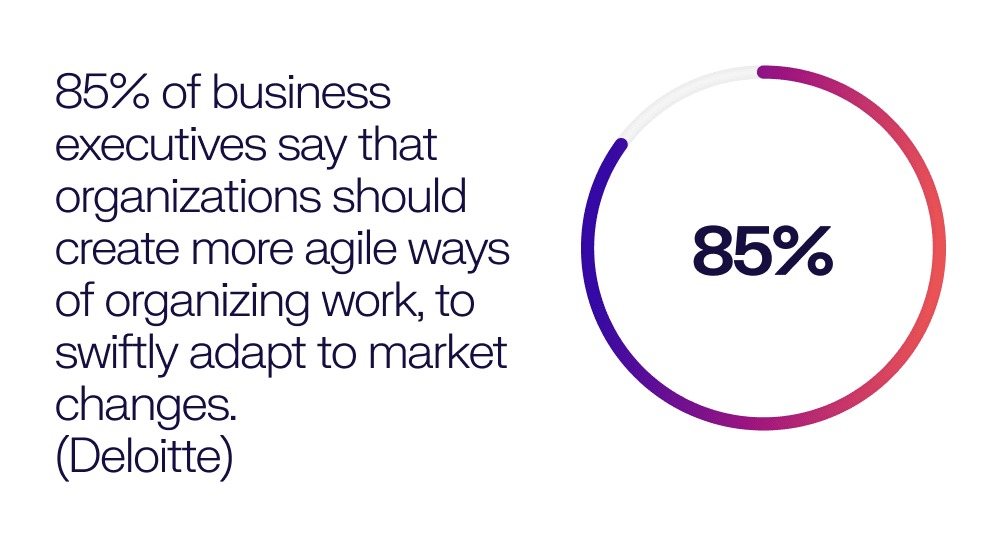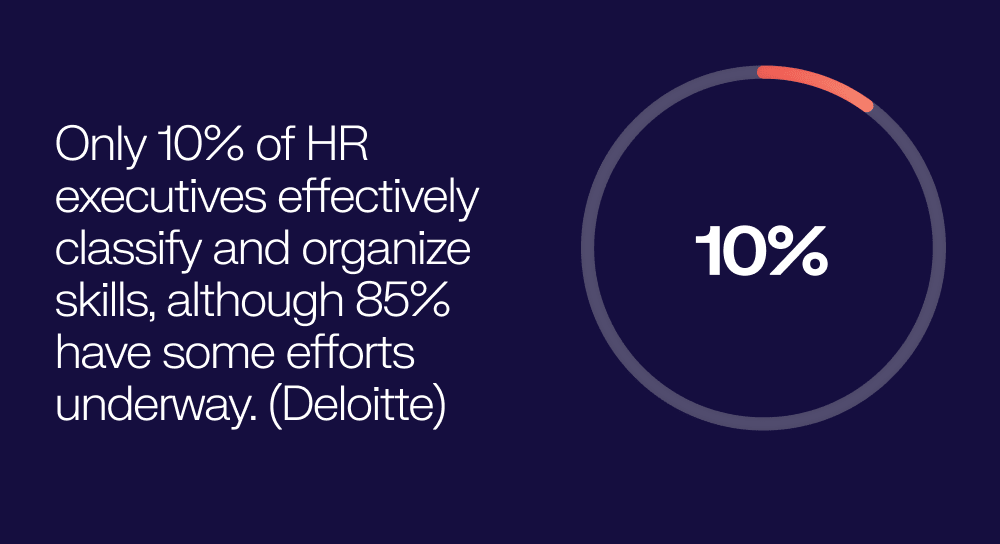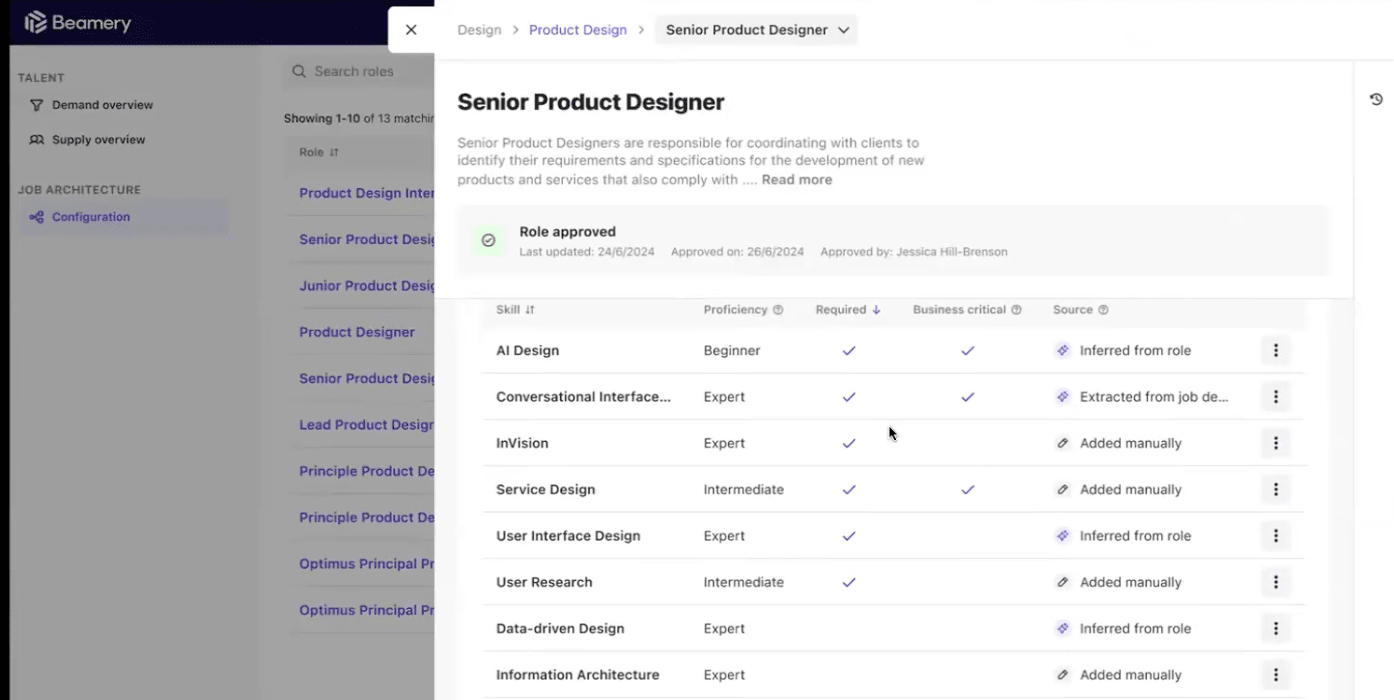Connecting HR To Business Success, With Beamery & SAP
How do you connect talent-related decisions with real business outcomes? Siloed technology has often created a divide here – but bridging the gap is essential for businesses to be successful. 
And talent agility is going to be essential. 58% of employees believe their skills will change over the next five years (World Economic Forum). More recent surveys suggest this shift is happening even faster – possibly within two years.
Meanwhile, 83% of Talent Acquisition leaders report struggling to find enough talent with the necessary skills.
Yet only 10% of HR executives feel they have a clear understanding of the skills within their organization. Whether you call it a skills framework, job architecture, or talent taxonomy, the real question is: How do you truly understand the skills you have (your employees) and the skills you need (your jobs)? In order to compete in a volatile market?
Understanding Skills Supply & Demand 📈
These two factors – knowing what skills exist in your workforce and what skills are required for success – are essential for everything from hiring to upskilling, and adapting to market shifts.
For example, if you’re in financial services, you may have seen a surge in demand for software engineers or data scientists to support digital transformation. In the world of tech, you may be facing a scarcity of specialist skills as new innovations abound.
Perhaps you’re dealing with a tight labor market or struggling to find candidates with rare skill sets. Your success rests on finding niche skills – the proverbial needle in the haystack – but the business doesn’t have an aligned view of what those skills are, never mind where to start looking for them.
Skills intelligence and AI technology can help businesses not only identify talent but also understand the work that needs to be done – aligning workforce planning with actual business needs. You can start to answer:
- What roles are required to execute our strategies?
- What capabilities and skills are needed for those roles?
- Should we hire, develop, or redeploy talent to meet those needs?
Why Skills-Based Transformation Feels So Hard 😔
Many organizations set out with a plan to become skills-powered, but when they try to implement it, they hit major roadblocks. Companies know where they want to go, but the sheer complexity of getting started often stops them in their tracks.
Historically, organizations approached skills and job frameworks through:
- Manual processes (spreadsheets, job descriptions, consultant-led projects)
- Long timelines (12–18 months to map skills across an organization)
- High costs (external consultants and internal resources)
These traditional approaches often fail because:
- They are time-consuming and expensive.
- The data becomes siloed (sitting in spreadsheets instead of core systems like SAP).
- They don’t scale or stay relevant – jobs and skills evolve, but the frameworks quickly become outdated.
The Solution: Building A Skills Data Foundation 🧱
The key to solving these challenges isn’t just implementing AI or automation – it starts with data.
Good data is the foundation for every successful AI-driven or skills-based strategy. The better your data, the greater your chances of success. That’s where Beamery comes in.
Our platform helps organizations quickly build a skills foundation, answering key questions like:
- What skills exist in my organization today?
- How do jobs relate to each other?
- What are the pathways for talent movement?
Beyond internal data, organizations need to align their skills strategy with external market shifts.
Skills are constantly evolving – some are emerging, others are becoming obsolete, and automation is reshaping the demand for certain capabilities. Meanwhile, competitors may be shifting their talent priorities, creating new pressures on hiring and retention.
By combining internal skills intelligence with market insights, organizations can move from understanding what skills they have today, towards anticipating what skills they will need tomorrow.
This forward-looking approach helps companies adapt to change, plan strategically, and make more informed workforce decisions.

Sellafield: Tackling Critical Skills Gaps With A Skills-Based Approach
Sellafield, a UK-based nuclear waste management company, faced a major hiring challenge. Highly specialized skills were in short supply; they couldn’t fill critical roles fast enough, and project timelines were at risk.
Despite having clear workforce demands, they struggled to attract and hire the specialized talent required to deliver on their contracts. This is a common concern for many organizations: knowing that they need certain skills but not having a strategy to ensure a steady pipeline of qualified candidates.
To solve this, Sellafield rethought their entire sourcing strategy using a skills-based approach. They needed to:
- Identify the exact skills required for each critical role.
- Expand their sourcing efforts to find talent with those skills.
- Engage candidates with highly personalized experiences.
Instead of relying solely on traditional job descriptions, they communicated skill needs externally – helping potential candidates understand what skills they needed to develop in order to transition into these roles. This approach not only broadened their talent pool but also gave job seekers a clearer path into the industry.
Sellafield worked with Beamery to build an engaged talent network, meaning they always have a pool of pre-qualified candidates when a new role opens. Now, when a job requisition is created in SAP Recruiting, it’s automatically pulled into Beamery, where recruiters can quickly match it against their existing candidate database.
The results?
- Reduced time-to-fill for critical roles.
- Higher quality of hires by focusing on skills.
- A continuous pipeline of skilled talent, ready when needed.
Sellafield leveraged our enterprise-grade CRM and candidate portals to centralize their talent acquisition efforts. By integrating SAP Recruiting with talent intelligence hub, they’re now extending this to include skills data, meaning:
- Skills are embedded into job profiles and hiring workflows.
- Job requisitions are directly linked to skills-based sourcing.
- Hiring decisions are aligned with real-time labor market insights.
This holistic approach doesn’t just help Sellafield with hiring – it also enables smarter workforce planning, by giving them rich, relevant insights about skills supply and demand.

A Single Skills Framework Across the Talent Lifecycle
Historically, organizations purchased HR solutions in silos: an ATS, then an onboarding system, then an LMS or LXP. While these tools may have been loosely connected from a hire-to-retire perspective, there was no unifying skills layer tying them together.
When you connect systems, and embed the logic of “skills” across the entire employee lifecycle – from recruiting to alumni management – you get the infrastructure to maintain a consistent skills story: one where the skills used in hiring are the same ones assessed, developed, and managed throughout an employee’s career.
At SAP SuccessFactors, this is achieved through a central skills system, the talent intelligence hub – a tool for defining the skills and attributes for job families and roles. This acts as the glue, aligning roles and individuals with a unified skills framework.
Organizations still need to be intentional about defining the skills unique to their business. This is a shift we’re seeing across our shared customers – moving beyond generic skills libraries to strategic, customized skills frameworks.
Getting meaningful skills data into SAP and making that data usable across the platform has traditionally been a very time-consuming process. However, Beamery can build a relevant taxonomy super quickly, from a range of sources – including the data you already have in your SAP systems.
For example, the information in your legacy job profiles can be used as a reliable source. Beamery can then apply AI to extract and normalize skills from that data and push it back into SuccessFactors, ensuring it's in a format that SuccessFactors understands. This means you don’t need to worry about manually building a skills and job library.

Bringing It All Together: The Skills-Based Lifecycle
Today, organizations can finally break down silos and create a cohesive skills ecosystem across all their talent processes.
Here’s how it works with SAP SuccessFactors and Beamery:
- Beamery takes existing skill taxonomies or unstructured job descriptions and generates a job, skill and capability taxonomy – benchmarking your organization’s data against the external market.
- Beamery pushes this data back into SAP’s talent intelligence hub.
- Employees get recommendations of skills to add to their profiles, as well as tailored career path suggestions, while Managers see which skills and proficiencies they ought to benchmark and validate their employees against.
- Beamery keeps the job, skill and capability taxonomy up to date based on external market data and the organisations hiring signals as they change over time.
One Beamery client faced significant workforce challenges: they’re undergoing a major transition and need to hire a large number of people in the coming years. Understanding skills is crucial for them. Together, SAP and Beamery have given them a seamless process to understand their workforce’s skills and jobs. This collaboration is helping this client optimize their human capital, reduce business risks, and improve operational efficiency.
By adopting skills-based hiring, they’ve significantly reduced their time to hire and interview, which ultimately boosts bottom-line efficiency.
Beamery and SAP together enable a complete view of talent, whether internal or external, ensuring you're making the most of your existing workforce rather than constantly looking outward. By effectively using skills at scale, you can stay agile in volatile market conditions, which helps reduce business risks.
Beamery is part of a connected ecosystem, enhancing the platforms you’ve already purchased from SAP. We focus on making those products smarter and more efficient for you.
Our powerful skills intelligence data can be used across all systems you’re currently using, whether it’s SAP, Beamery, or others. It’s also customizable. We don’t just offer an out-of-the-box solution; we create unique skill taxonomies tailored to each customer’s needs.
Want to learn more? Watch our webinar with SAP, or read more about the Beamery & SAP partnership here.